After a long break, the Bundesliga finally returned and we got to see high-class football for the first time in some weeks. While a huge focus was on the games Borussia Dortmund vs Schalke 04 or Eintracht Frankfurt vs Borussia Mönchengladbach, a lot of the people forgot about another important match: Fortuna Dusseldorf vs Paderborn. While the other games were interesting as we had top teams facing each other in the race for the title and UEFA Champions League spots, this was a pure relegation battle.
Ahead of this game, Paderborn was in the last position with 16 points out of the opening 25 games and Fortuna Düsseldorf was in the 16th place with 22 points. Therefore, both teams needed to get points in this match and especially for Paderborn it was a huge chance to collect something in the fight against relegation.
In this tactical analysis, we will look at the tactics of both sides and discuss what led to the fact that the match ended 0-0 what none of the two teams really helps.
Lineups
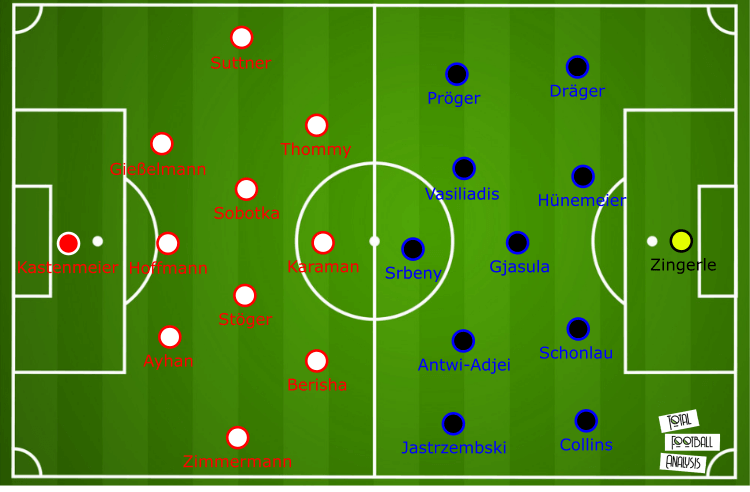
The home team went with a 3-4-3 and a 3-4-2-1 respectively, but you have to note at this point that the three forwards were very flexible and often exchanged their positions. Florian Kastenmeier was in goal as the Manchester City loanee Zack Steffen is currently injured. The back three consisted out of Kaan Ayhan, André Hoffmann and Niko Gießelmann while the wing-backs were Markus Suttner and Matthias Zimmermann. Kevin Stöger and Marcel Sobotka. Valon Berisha and Erik Thommy supported upfront Kenan Karaman.
On the other side, Steffen Baumgart went for a 4-1-4-1 and a 4-3-3 formation respectively with Leopold Zingerle between the sticks and the back four was made of Jamilu Collins, Uwe Hünemeier, Sebastian Schonlau and Mohamed Dräger. Klaus Gjasula was the player between the two banks of four and was supported in the centre by Christopher Antwi-Adjei and Sebastian Vasiliadis. The wings were occupied by Dennis Jastrzembski and Kai Pröger. Upfront Dennis Srbeny who joined Paderborn in the winter from the Premier League side Norwich City was the only striker.
Paderborn dominating the majority of the match
Before we now dive into the build-up patterns of Paderborn and defensive tactics of Fortuna Düsseldorf in this tactical analysis, I need to note that we mainly focus in this analysis on the two possession phases of the teams since we rarely saw counter-attacks and counter-pressing moments in this match. The main reason for that is that you need to consider that this was for the players a new situation as they hadn’t got a normal preparation for this game. Due to that, the intensity was a bit lower compared to the games before the long break.
Basically, the formation of Paderborn stayed during the build-up the same as they used their 4-1-4-1 but stretched the pitch as much as possible. Both full-backs, as well as the wingers, tried to stay near the touchline and the two centre-backs were responsible with the organisation of the build-up. Gjasula was extremely important for his team’s progression of the ball, but we will talk about this in more detail in the following sections of this tactical analysis.
In the image below we can see the basic structure of Paderborn during the build-up as well as the 3-4-3 and 5-2-3 respectively of Fortuna Düsseldorf who switched the height of their pressing line throughout the game, but put pressure on the opponents at the latest at the height of the halfway line. Gjasula was permanently in the space between the three forwards of Düsseldorf and their two central midfielders who looked after the two central men of Paderborn. We can see these aspects of the game perfectly in the shot below.
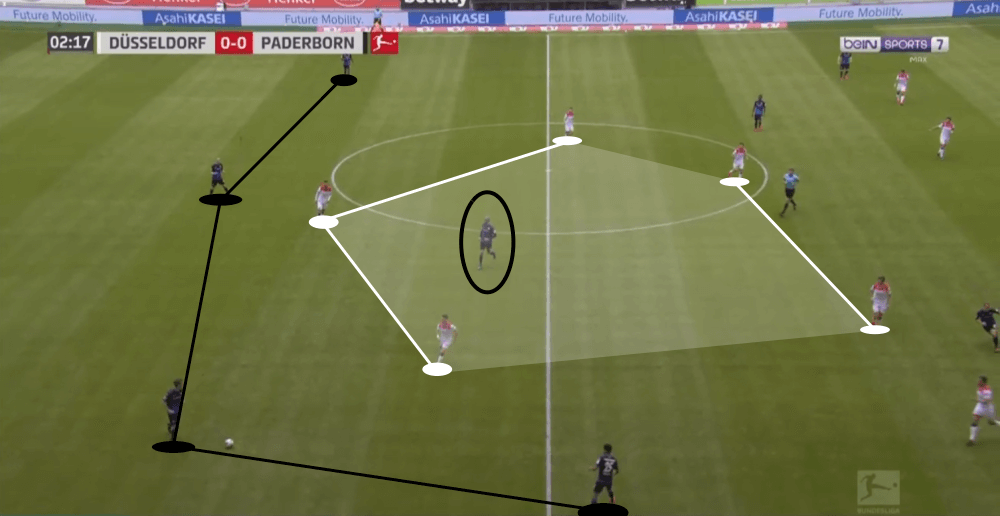
Basically, Paderborn dominated the majority of the game and was more patient during the build-up as we can see when we look at some numbers. Paderborn had 53% of possession and 103 periods of possession while Düsseldorf had 47% and 104 periods of possession. However, they were almost never able to convert this seemingly light dominance into actual goalscoring chances as their xG tells us. They had after the final whistle of the referee five shots (one on target) and an xG of 0.52.
They had three ways with which they mainly tried to progress the ball further up the pitch and we will now look at these three patterns. The first one was that the full-back should have a little interplay with the winger in front of them to get forward. In this situations, they wanted to make use of the pressing pattern of Düsseldorf which was really simple: as soon as the ball was played from the goalkeeper or one of the two centre-backs to the full-back in the wide-area the outer man of the front three would start the press by sprinting towards the wide-defender. Paderborn (especially on the left side) tried to exploit that Berisha and Thommy mainly did that with full speed with a give and go as we can see in the example below. After these two passes, the full-back would then try to dribble forward and get into the half-space or find a teammate in a higher line.
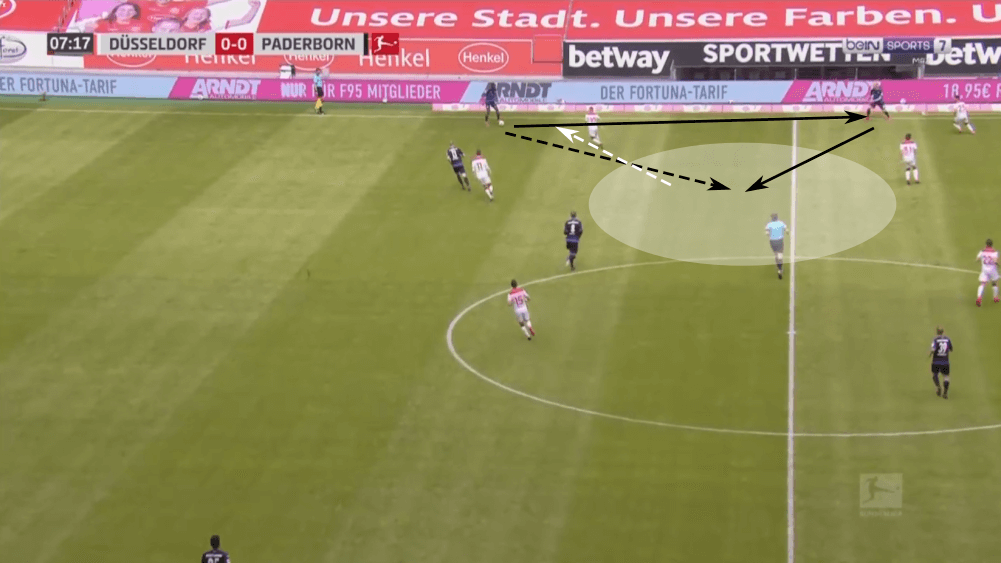
The second pattern was to find the defensive midfielder Gjasula behind the three forwards of Düsseldorf who then should try to turn and then play the ball forward. The Albanian moved, therefore, permanently from one side to the other to open up passing lanes towards him and was incredibly active. We will look at him and his performance in more detail in the next section of this tactical analysis, but in the image below we can see an example for the second pattern.
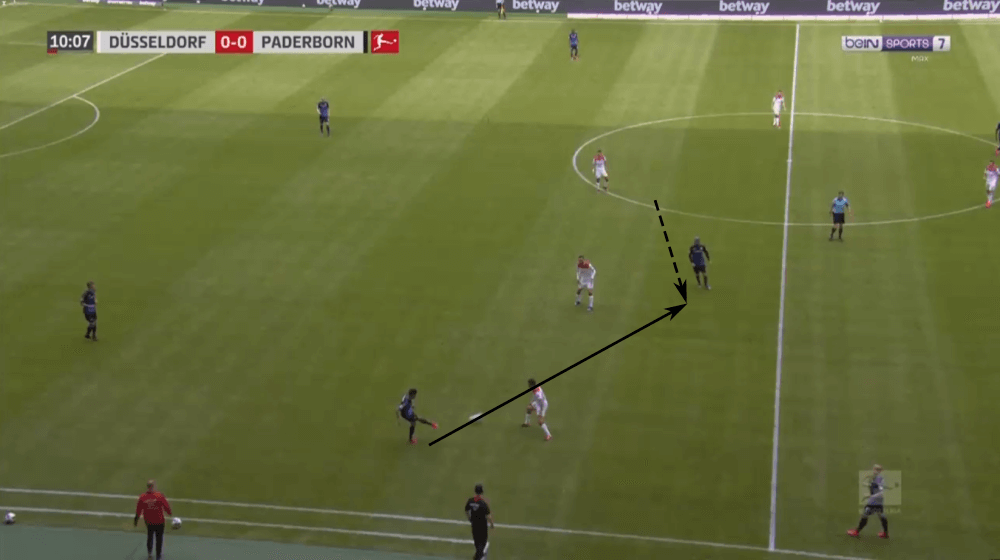
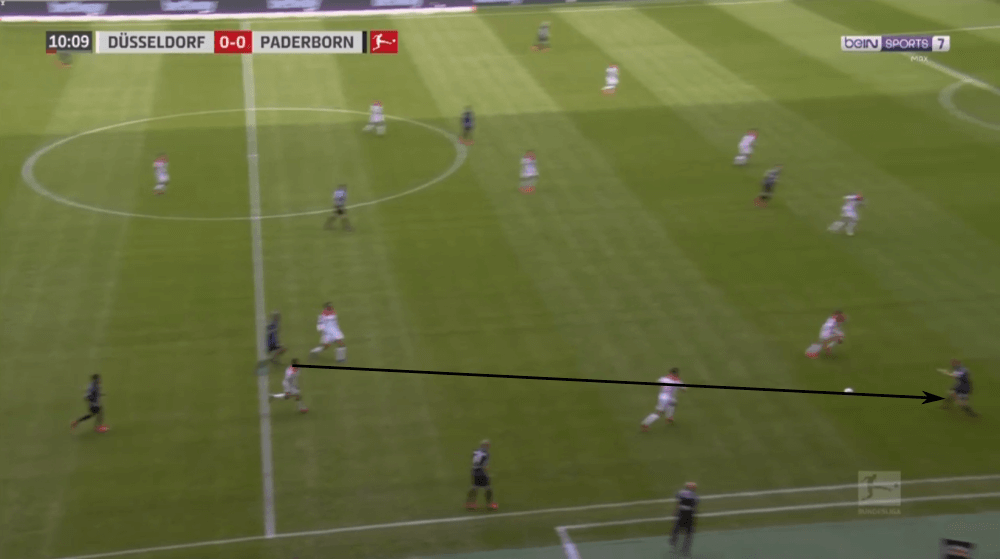
The third and last way to get forward was usually the last option which they used as soon as none of the first two was available due to the good organisation of Düsseldor: a long vertical ball towards the single striker Srbeny. Due to the lack of support from his teammates the German striker often had a hard time, but considering this he did quite well. In the shot below we see a typical example for this third pattern which rarely really worked off.
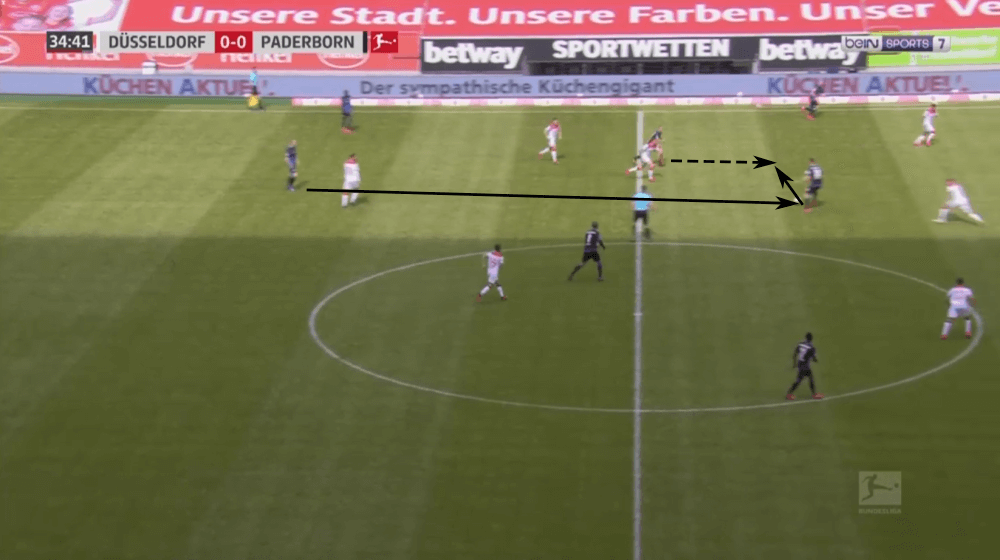
Neither Fortuna Düsseldorf nor Paderborn had phases in the game when they sit back deeper for a long time, but always put pressure on the opposition at the latest at the height of the halfway line. However, when the team of Baumgart lost the ball on a higher area, his team immediately started a man-orientated counter-pressing. Even though Düsseldorf rarely even attempted a counter-attack, due to this counter-pressing they weren’t even able to start a new build-up. Considering this, the counter-press of Paderborn helped them massively to get more control of the game even though they were rarely able to get forward as mainly due to unprecise actions none of the three patterns worked off regularly.
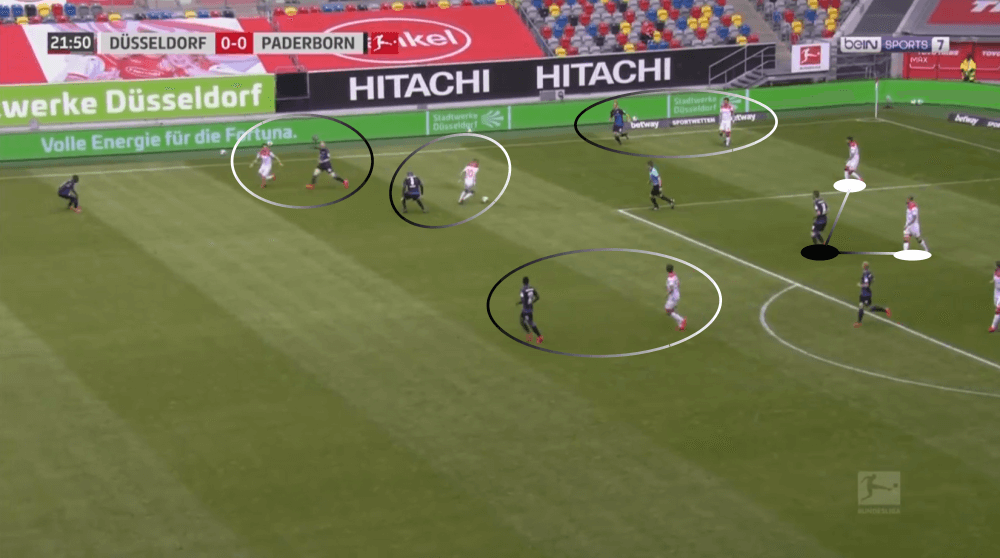
Gjasula as key player
The role of the Albanian was quite interesting to watch, and his importance got visible in the second 45 minutes as he got subbed off in the half time. He was permanently moving from one side to the other to be an option for the defender on the ball. He almost never exited the space between the three forwards of Düsseldorf and the two central men. However, as I already mentioned, Paderborn was extremely patient and rarely found a way to break through. Due to that, it’s no surprise that the four defenders, as well as the goalkeeper, were the four players with the most touches after the 90 minutes as we can see in the image below.
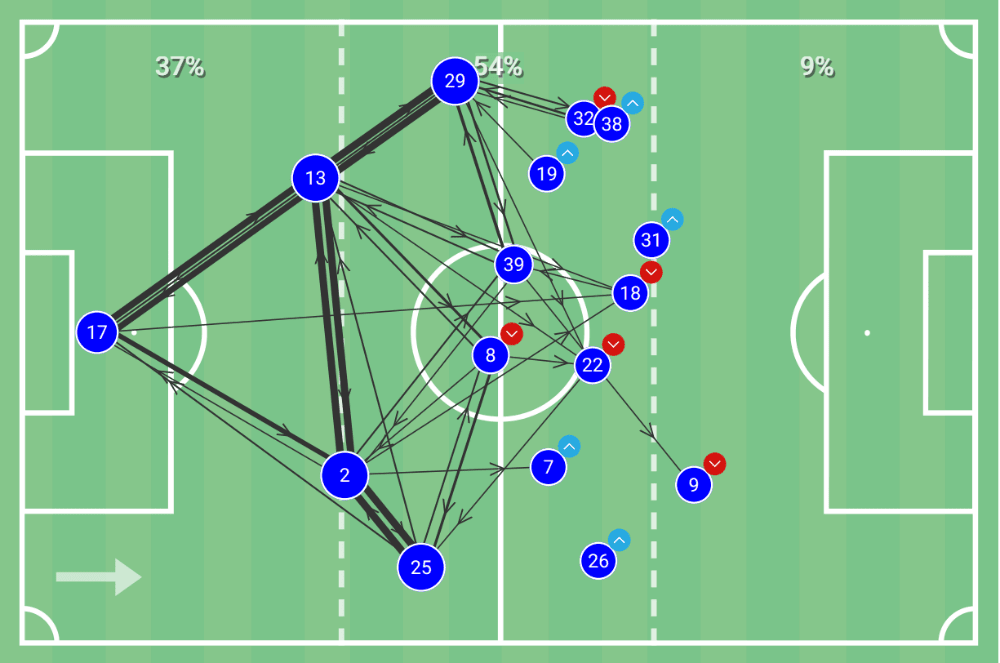
Even though Gjasula played only 45 minutes, he completed 23 passes what is the sixth-highest values of all players of Paderborn. Only the four defenders, the keeper and Vasiliadis who played in the first half as number eight and in the second one he went back to occupy the position of Gjasula, but the Greek did that completely different.
While in the first half the front three of Düsseldorf mainly used their cover shadow to cut off the passing lanes towards Gjasula, in the second 45 minutes, they often tightly followed Vasiliadis to take him out of the game as we can see below.
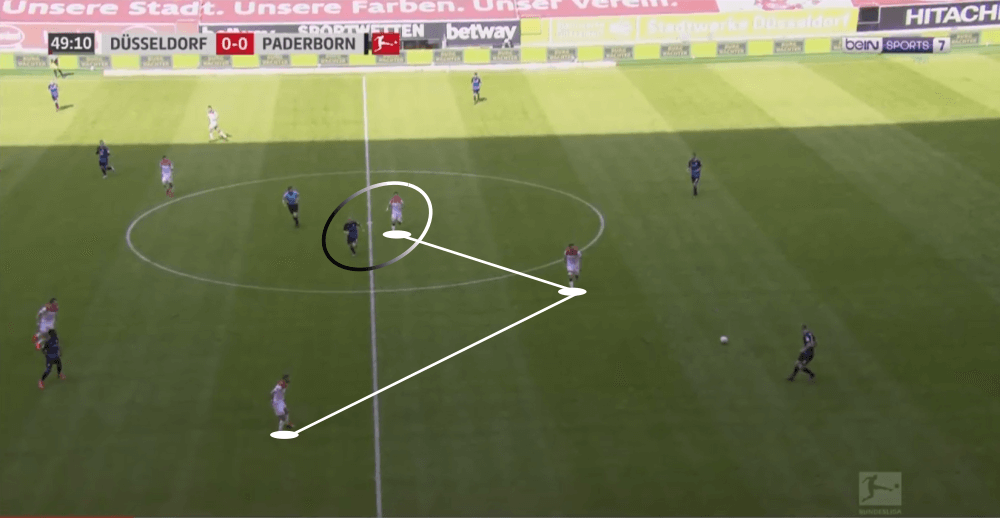
Additionally, the young Greek is just a different type of player compared Gjasula and therefore he wasn’t that active in the deeper areas, but instead went forward. This made it for the back four even harder to progress the ball further up the pitch as they haven’t had anymore this one man in front of them who permanently tried to give them an option in the centre. In the shot below we can see a typical situation in the second half when Vasiliadis positioned higher.
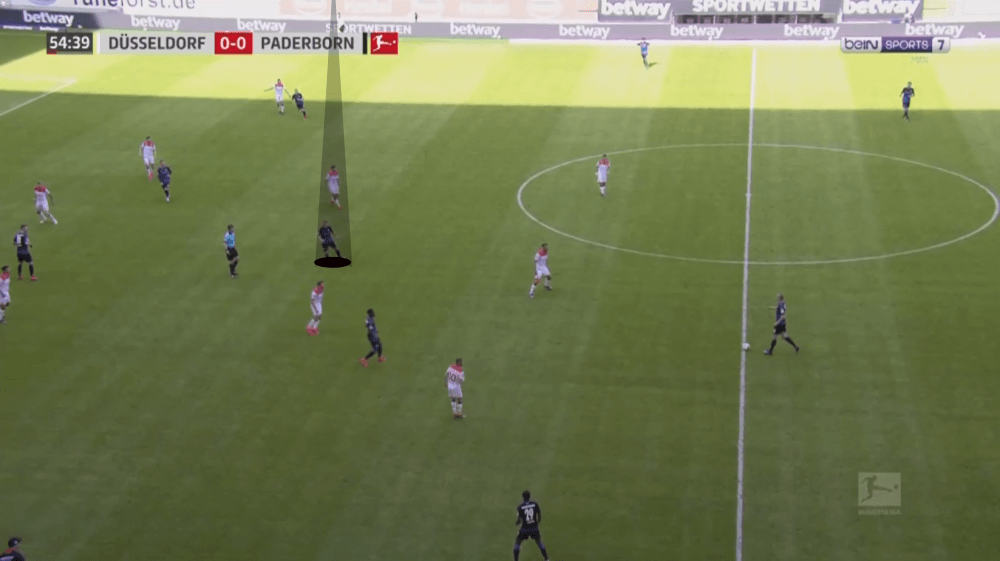
Because of these aspects, Paderborn had in the second half more problems to get forward. Considering that Gjasula was the important man for one of their three patterns, this was logical. Anyways, we can also see in some stats that the Albanian and Vasiliadis acted differently in the same position in front of the back four.
When we compare the numbers of the two players in each half, Gjasula completed 23 of his attempted 26 passes while 15 of Vasiliadis’ 19 passes found a teammate. Additionally, the Albanian completed three passes to the final third while Vasiliadis has for this category in the second half only a value of one. Considering these two metrics, we can see again that Gjasula helped his team more during the build-up.
Even though you should be careful when you use the statistic total actions, we will use it now to compare the general activity of these two players (of course you need to keep in mind that these were the second 45 minutes for Vasiliadis). Gjasula has a value of 42 while his Greek teammate only had in total 29 actions. All in all, we can see in the statistics, that Paderborn couldn’t rely that much on their defensive midfielder in the second half when it comes to the progression of the ball and due to that they rarely entered the final third.
Düsseldorf’s progression of the ball
Now, in the last part of this tactical analysis, we will look at the build-up and attacking patterns of Fortuna Düsseldorf. They weren’t as patient as their opponents and additionally Paderborn occasionally pressed quite high, but the team of Uwe Rösler was by far more dangerous than the opposition.
They stayed in their 3-4-3 formation during the build-up, but the two central midfielders, as well as Berisha and Thommy, were quite flexible. We primarily saw that either Sobotka or Stöger stayed deeper while the other one positioned in the higher areas. The wing-backs hugged the touchline while Thommy and Berisha were mostly in the half-spaces but also moved to the outside or into the centre. In the shot below we can see their typical structure with the back three and Stöger in front of it against the 4-1-4-1 of Paderborn.
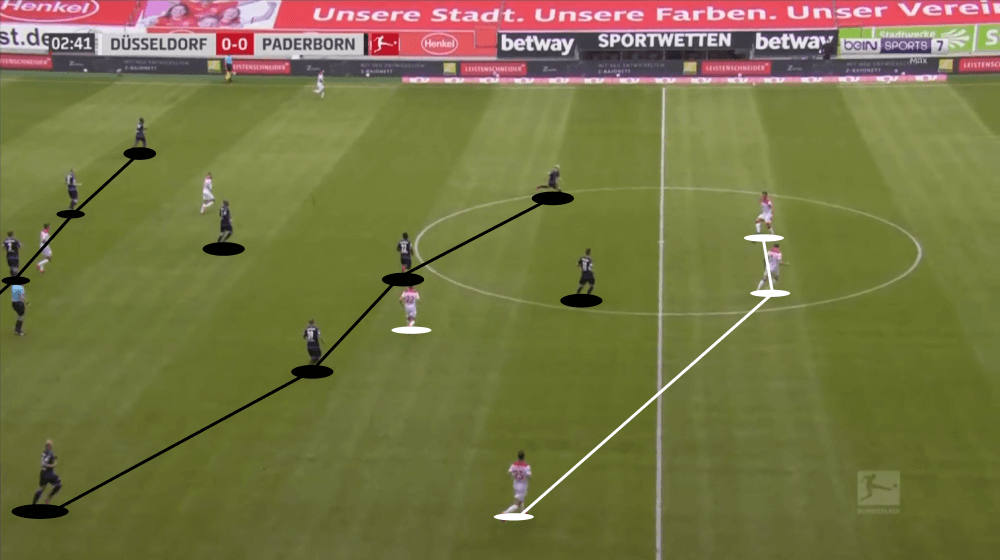
Whenever Baumgart’s squad decided to use a higher pressing, they mainly acted quite man-orientated and created numerical equality. In such situations, a ball-playing goalkeeper can be very helpful especially when you want to overcome the press with the aid of short passes like Düsseldorf did. As we can see in the example below, they used Kastenmeier to have one more player in the first third and solved the situations calmly with short passes and created permanently triangles.
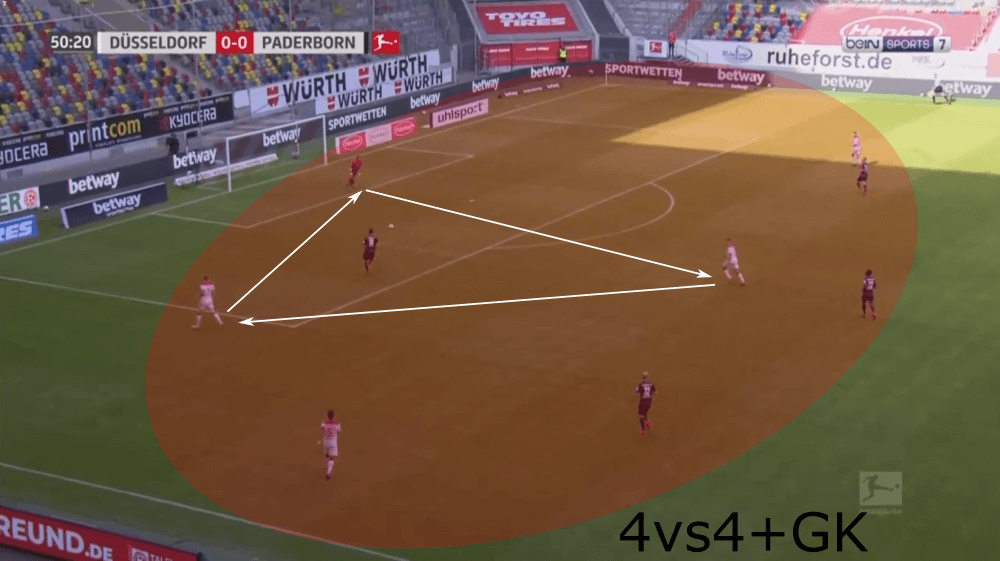
While for Paderborn their single striker was one of three options to bring the ball forward, Karaman was for Düsseldorf besides long balls to the wings the main way to get forward. Several times throughout the match the three defenders wanted to break the opposition’s midfield line with vertical passes to find the central striker who then would lay the ball off for a teammate as we can see in the example below.
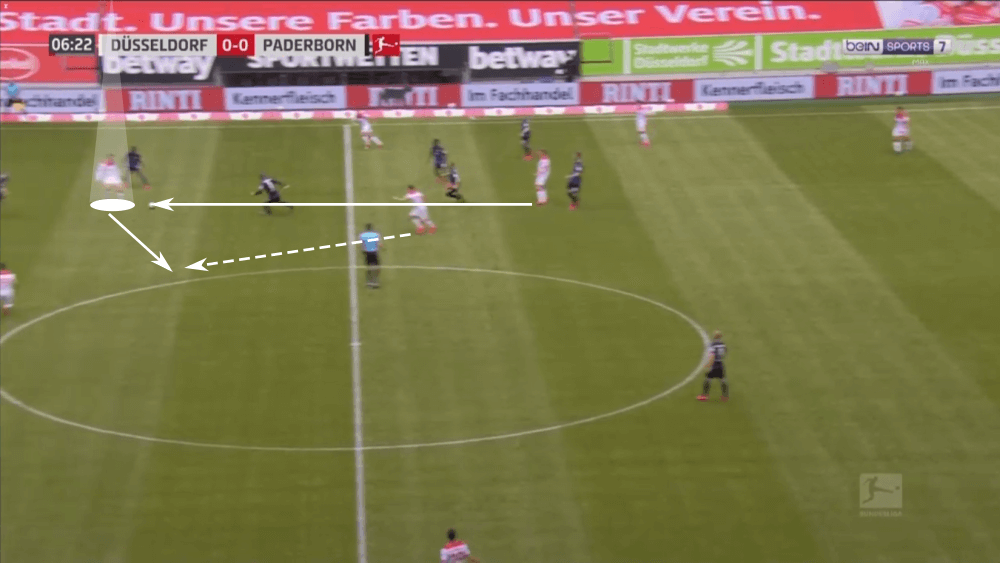
Anyways, even though this was their preferred way to get the ball to Thommy and Berisha who are clearly the most creative and deadliest players when they have the ball at their feet of Düsseldorf, this option wasn’t always possible due to Paderborn’s compactness. They tried to stay especially horizontal compact and offer Düsseldorf no gap between the midfielders through which they could find Karaman.
Due to that, Ayhan, Hoffmann and Gießelmann had often a hard time to play these forward passes towards their single striker. But this horizontal compactness of Paderborn led to a lot of space in the wide-areas which they exploited with balls to the wing as we can see in the example below.
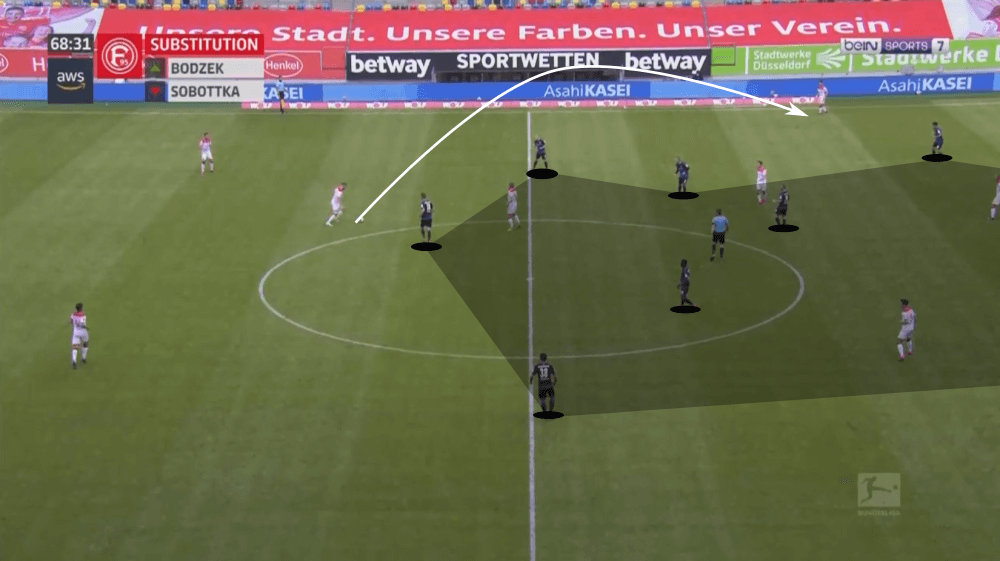
Anyways, they didn’t just play balls from the centre to the wide-areas but also tried to switch the side with long balls to exploit the free space on the far hand side. Especially the right part of the back three Ayhan played such long balls to the left-wing over and over again. Below, we can see the map for his long passes in this game and we can see that he played 12 successful long balls and the majority of them were from the right side to the left-wing.
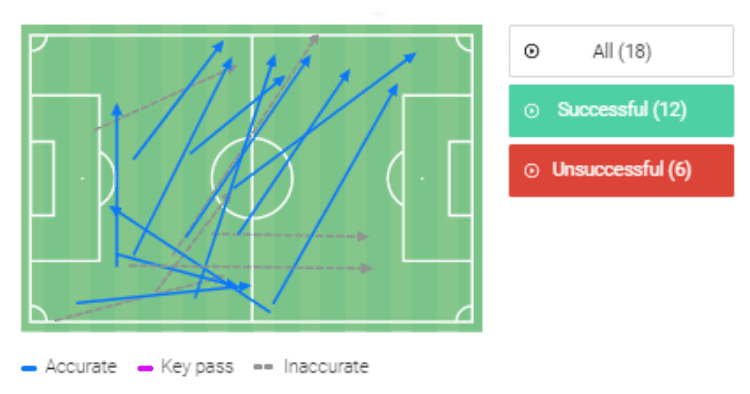
Also, the usage of the wide-areas was their main pattern in the final third as three out of their four greatest chances in the game resulted out of attacks down the wing where they exploited the horizontal compactness of Paderborn.
Conclusion
All in all, we can conclude that there are two main reasons why we saw no goals in this game: Paderborn were rarely able to create goalscoring chances while Düsseldorf had those, but didn’t convert them.
This 0-0 helped none of these two teams and the only team who win in this case are Werder Bremen who will face Bayer Leverkusen today. Bremen could exploit the draw between Düsseldorf and Paderborn to bring themselves in a better position the battle against relegation. However, it will be hard for them to get a draw or even a win against Leverkusen.





Comments